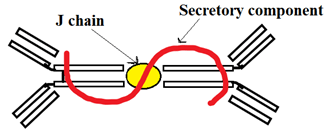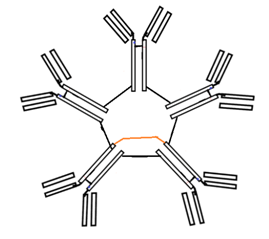This set of Protein Engineering written test Questions & Answers focuses on “Applications – Antibody – 2”.
1. Which of the following technology has made it feasible to prepare large quantities of monoclonal antibodies (MAbs) with a defined antigen specificity?
a) Southern blotting
b) PCR
c) rDNA technology
d) Hybridoma technology
View Answer
Explanation: Hybridoma technology has made it feasible to prepare large quantities of monoclonal antibodies (MAbs) with a defined antigen specificity. MAbs can be generated against almost any antigen of interest and, therefore, are widely used in both diagnosis and therapy, including cancer, infectious diseases, and in the modulation of the immune response in transplantation.
2. The amino-terminal domains of both heavy and light chains are variable; in that, they differ in amino acid sequence from antibody to antibody.
a) False
b) True
View Answer
Explanation: The above statement is true. The amino-terminal domains of both heavy and light chains are variable; in that, they differ in amino acid sequence from antibody to antibody. The other domains are constant, that they have the same amino acid sequence for a given antibody chain of the same isotype except for a single amino acid difference at a few positions.
3. Which of the following domains is responsible for antigen recognition and binding of antigens?
a) C domains
b) CH1 domain only
c) CH1 and CH2 domains
d) V domains
View Answer
Explanation: V domain is responsible for antigen recognition and binding of antigens. C domains, CH1, and CH2 domains are not responsible for antigen recognition and binding of antigens. C domains of the antibody molecule mediate the binding of the immunoglobulin to the effector molecules.
4. Which of the following bonds help in the association of antibody H and L chains?
a) Peptide bonds
b) Ionic bonds
c) Hydrogen bonds
d) Disulfide bonds
View Answer
Explanation: Disulphide bonds help in the association of antibody H and L chains. The H and L chain halfmers are covalently bonded by disulfide bond in the H chain hinge region, and the number of hinge disulfide bonds is variable and depends on the H chain isotype.
5. The antibody shown in the figure below belongs to which of the following class?

a) IgG
b) IgD
c) IgE
d) IgA
View Answer
Explanation: The antibody shown in the figure above belongs to the IgA class. IgA antibodies consist of heavy (H) and light (L) chains. Altogether the combined molecular weight of IgA is around 160 kDa. IgA antibody is the most abundant antibody class in human serum and has a unique role in mediating immunity. The two antibody units are joined by a joining chain (J chain).
6. The hinge region is flexible and susceptible to proteolytic digestion.
a) False
b) True
View Answer
Explanation: The above statement is true. The hinge region is flexible and susceptible to proteolytic digestion. The proteases digest immunoglobulin (IgG) molecules into the Fab (fragment of antigen-binding) and the Fc (fragment that crystallizes) fragments.
7. How many complementarity-determining regions (CDRs) are present in an IgG molecule?
a) Three
b) Ten
c) Six
d) Twelve
View Answer
Explanation: Twelve complementarity-determining regions (CDRs) are present in an IgG molecule. There are three CDRs in each of the L and H chains and these six CDRs fold to form the antibody binding site. As there are two antigen-binding sites on an antibody molecule, the total number of CDRs in an antibody is twelve. These CDRs form loops, which are located at one end of the V domains.
8. Which of the following is a hybrid molecule that consists of non-identical heavy and light pairs, resulting in two different antigen specificities?
a) Chimeric antibody
b) Monoclonal antibody
c) Humanized antibody
d) Bispecific antibody
View Answer
Explanation: Bispecific antibody is a hybrid molecule that consists of non-identical heavy and light pairs, resulting in two different antigen specificities. These molecules are used in cell targeting, complement-mediated cytotoxicity, and immunoassays.
9. Which of the following is not true for the production of monoclonal antibodies by conventional methods?
a) unsuitable for use
b) Time-consuming
c) Expensive
d) Inexpensive
View Answer
Explanation: Making monoclonal antibodies by conventional methods is time-consuming and expensive, and in some instances, the resulting monoclonal antibodies may be unsuitable for use. Hence, the statement that the conventional method is inexpensive is not true. Recombinant antibody technology is being developed that may remove these limitations.
10. The digestion of IgG antibodies with papain produces how many fragments?
a) Four
b) One
c) Two
d) Three
View Answer
Explanation: The digestion of IgG antibodies with papain produces three fragments. It does not produce four, one, or two fragments. After the digestion of IgG antibody with papain, two Fab fragments and one Fc fragment is produced. Papain is also known as papaya proteinase I. It is a cysteine protease present in papaya.
11. Which of the following consists of antibody VL fused to a VH by a linker peptide?
a) Humanized antibody
b) Chimeric antibody
c) Fragment of crystallization (Fc)
d) Single-chain Variable fragment (ScFv)
View Answer
Explanation: Single-chain Variable fragment (ScFv) consists of antibody VL fused to a VH by a linker peptide. A humanized antibody, chimeric antibody, or fragment of crystallization (Fc) does not consist of antibody VL fused to a VH by a linker peptide. The main advantages of ScFv are the rapid clearance from human circulation and reduced toxic side effects.
12. The antibody shown in the figure below belongs to which of the following class?

a) IgG
b) IgA
c) IgD
d) IgM
View Answer
Explanation: The antibody shown in the figure above belongs to the IgM class. IgM is the largest antibody and is the first antibody to appear in response to initial exposure to an antigen. IgM is constructed of five or six units (mostly as pentamers but hexamers also occur).
13. The primary function of the linker in the ScFv molecule is to orientate the V domains into a specific structure to form the active binding site.
a) True
b) False
View Answer
Explanation: The above statement is false. The primary function of the linker in the ScFv molecule is to maintain the proximity between the two V domains. The linker is not required to orientate the V domain into a specific structure to form the active binding site.
14. Which of the following is the cellular receptor of HIV-1 envelope glycoprotein gp120?
a) CD12
b) CD3
c) CD8
d) CD4
View Answer
Explanation: CD4 is the cellular receptor of HIV-1 envelope glycoprotein gp120. The first step in the infection of human T lymphocytes, macrophages, and other cells by human immunodeficiency virus (HIV-1) is the attachment of the HIV-1 envelope glycoprotein gp120 to its cellular receptor, CD4.
15. The digestion of IgG antibodies with pepsin produces how many fragments?
a) Four
b) One
c) Three
d) Two
View Answer
Explanation: The digestion of IgG antibodies with pepsin produces two fragments. It does not produce four, one, or three fragments. After the digestion of IgG antibody with pepsin, one Fab’ fragment and one Fc fragment is produced.
Sanfoundry Global Education & Learning Series – Protein Engineering.
To practice all written questions on Protein Engineering, here is complete set of 1000+ Multiple Choice Questions and Answers.
If you find a mistake in question / option / answer, kindly take a screenshot and email to [email protected]
- Check Biotechnology Books
- Practice Biotechnology MCQs
- Apply for Biotechnology Internship
- Check Protein Engineering Books
